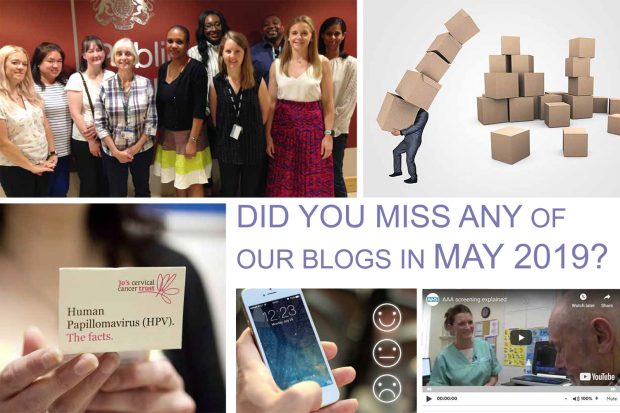
Here is a round-up of all 23 screening blogs we published in May 2019.
Abdominal aortic aneurysm (AAA) screening
e-Learning for AAA screeners and clinical skills trainers updated
We have refreshed and updated the 2 national e-learning units for screeners in the NHS AAA Screening Programme.
Short film aims to reduce barriers to AAA screening attendance for men with learning disabilities
The Dorset and Wiltshire AAA Screening Service has developed a short film, available to view on YouTube, to explain the screening process.
Breast screening
More reporting radiographers in breast screening
Funding is available to support the training of 150 additional reporting radiographers in England during the 2019 to 2020 financial year – an initiative that includes the breast screening workforce.
Breast screening units – the Sloane Project needs you
Breast screening units we need you. Please take part in the latest Sloane audit.
Cervical screening
Raising awareness of HPV – a view from Jo’s Cervical Cancer Trust
The second in a series of blogs we're running by Rob Music, chief executive of Jo’s Cervical Cancer Trust. The focus of this one is on raising awareness of human papillomavirus (HPV) with the upcoming roll-out of HPV primary screening.
Diabetic eye screening
Updated national diabetic eye screening standards published
The NHS Diabetic Eye Screening Programme has published revised national pathway standards that apply to all data collected from 1 April 2019 onwards.
We need your feedback on KPI for diabetic eye screening referrals
We are asking local diabetic eye screening providers to help us understand the challenges they face in achieving the national standard for timeliness of referrals from screening.

Fetal anomaly screening
Antenatal ultrasound scan information sheets updated
We have updated and improved the national information we provide about the ultrasound scans offered to women during pregnancy.
General information
A better approach to large print and audio versions of leaflets
We are changing how we provide large print and audio versions of our screening leaflets to make it easier and quicker for people with visual impairments.
Digital information opportunities ahead
Moving towards digital methods for providing screening information presents an opportunity for us to be innovative and add value to local screening services.
Improvements to our Screening Tests For You and Your Baby booklet
Learn about all the changes and improvements to our Screening Tests For You and Your Baby leaflet.
Keeping up the momentum to tackle inequalities in screening – have we made a difference?
A year ago we launched the PHE Screening inequalities strategy. Please complete a short survey to tell us if it is having a positive impact.
Learning from the experiences of others in antenatal screening
Some important points of learning to be aware of from antenatal screening safety incidents.
Make sure your leaflets do not get lost in the post
Simple guidance for local screening services that place orders for national leaflet deliveries to ensure stock does not go missing or undelivered.
Making sure the UK NSC keeps recommendations up to date
The UK National Screening Committee (UK NSC) evidence team is trialling a new approach to make the process of reviewing evidence for screening more efficient.
Popular antenatal and newborn screening e-learning module gets a refresh
We are pleased to announce the launch of a refreshed and updated version of our antenatal and newborn screening e-learning module.
Screening KPI data published for third quarter of 2018 to 2019 year
Key performance indicators (KPIs) measure how the NHS screening programmes are performing and aim to give a high level overview of programme quality. This blog article updates you on the latest KPI data publications.
Tackling screening inequalities in BAME communities
A health programme manager explains how the charity she works for is tackling screening inequalities in black, Asian, and minority ethnic (BAME) communities.
Infectious diseases in pregnancy screening
Infectious diseases in pregnancy screening data report out
The 2016 to 2017 infectious diseases in pregnancy screening (IDPS) programme standards report is out.
Newborn blood spot screening
Exciting new features for newborn blood spot failsafe system
Some fantastic new features have been added to the newborn blood spot screening IT system.
Julie retires with happy memories and satisfaction at impact of screening
Julie Wilcox has retired after 5 years leading the Newborn Blood Spot Failsafe Solution (NBSFS) project.
New e-learning on newborn blood spot samples
We’ve launched a new e-learning module on blood spot screening samples that explains what could happen if a baby has a poor quality sample.
Sickle cell and thalassaemia screening
Is elevated fetal haemoglobin a cause for concern in antenatal screening?
The sickle cell and thalassaemia screening support service provides advice on when antenatal screening results involving a raised level of Hb F, the fetal version of haemoglobin, should be followed up.
PHE Screening blogs
PHE Screening blogs provide up to date news from all NHS screening programmes. You can register to receive updates direct to your inbox, so there’s no need to keep checking for new blogs. If you have any questions about this blog article, or about population screening in England, please contact the PHE screening helpdesk.